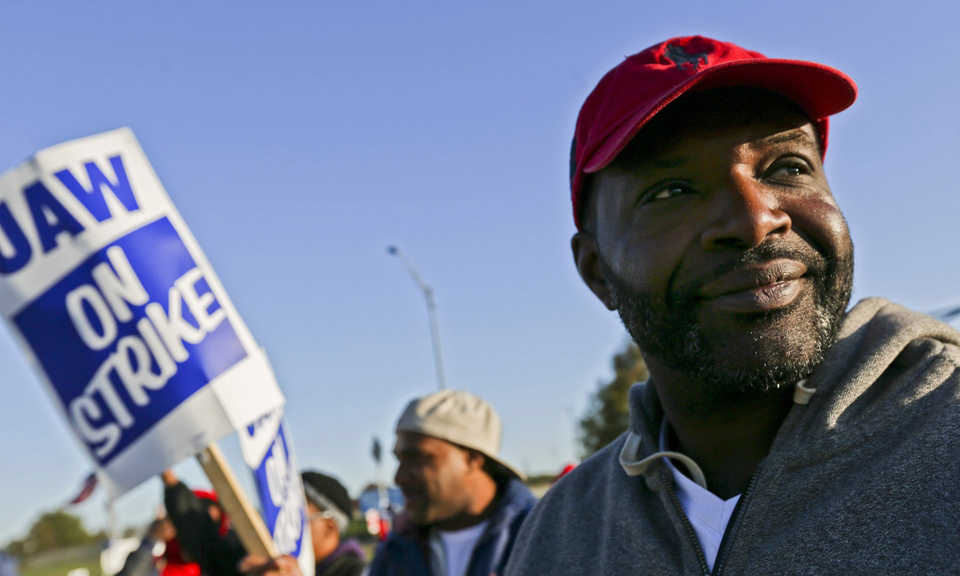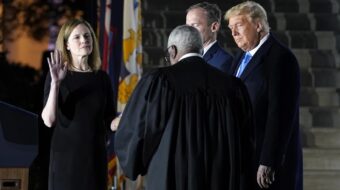
WASHINGTON—U.S. workers are increasingly pissed off. And as a result, 25 times their bosses forced at least 1,000 of them to strike last year. That was a 19-year high.
And that doesn’t include GOP President Donald Trump’s lockout of approximately 400,000 federal workers for the whole month of January and the last week of December 2018.
That “pissed off” conclusion, in polite language, came from AFL-CIO President Richard Trumka after the Bureau of Labor Statistics released its strike figures for 2019. Trumka called the rising number of mass strikes evidence of “a sea change in America.”
“In 2019, nearly half a million workers sacrificed the comforts of today for the progress of tomorrow. These strike statistics represent nothing less than a sea change in America,” the AFL-CIO chief said on Feb. 11.
“Working people — completely fed up with an economic and political system that does not work for us — are turning to each other and using every tool at our disposal to win a better deal. Because of the courage of every worker who said enough is enough, we all stand on a stronger foundation today. Solidarity works. And we’re just getting started,” he vowed.
BLS said there were 25 work stoppages last year, compared to a yearly average of 15 in the decade before. In those 25 cases, bosses forced 425,500 workers to walk – just below the 485,200 who were forced to strike in 2018, but in fewer stoppages (20). In 2019, workers lost 3.244 million days off the job, or 0.01% of all work time, the same share as in 2018.
The longest 2019 strike, BLS said, was when GM CEO Mary Parra forced 46,000 United Auto Workers to walk for 49 days late in the year. That job action alone took up 1.34 million workdays for all those workers.
But teachers and support staffers were 63% of last year’s workers who were forced to walk, BLS said. They had to hike off the job when cities and states – such as Chicago, Los Angeles, and Denver – wouldn’t remedy lousy conditions, low pay for support staff, aging books and lack of funding for public schools.
Teachers and staffers also accounted for the largest strikes of the last two years, BLS said. Interestingly, those strikes involved teachers in so-called “right to work” states, including one, North Carolina, that legally bars public union strikes of all kinds.
Some 123,000 North Carolina Association of Educators workers had to strike against the stinginess of the heavily GOP state legislature in 2018, followed by 92,700 last year. And the Arizona Education Association’s “#RedforEd” walkout, with enormous community support, made national headlines when 81,000 of its members had to strike from April 26-May 3, 2018. That strike revealed schools’ leaky roofs, buckled floors, and 25-year-old textbooks.
It also forced the GOP governor and legislature to provide more funds for the schools.
While the GM strike lasted 49 days and involved tens of thousands of workers, it – and other stoppages involving more than 1,000 workers each – was much smaller, combined, than cases of management forcing workers to strike before 1981, historical BLS data show.
The peak year for large management-forced strikes was 1952, with 470 strikes involving 2.75 million workers out for a combined 48.82 million workdays, 0.38% of all working time.
In terms of length, frequency and number of workers, such strikes sharply declined after 1981. Not coincidentally, GOP President Ronald Reagan arbitrarily fired the nation’s 14,000 air traffic controllers that year. The controllers, members of PATCO, were forced to strike for safety reasons.
Reagan permanently replaced all of them – and private-sector bosses saw his success against the union as a signal for “open season” on workers and strikers ever since. Large strikes hit their nadir in 2009, the first full year of the financier-caused Great Recession: Five strikes, involving 12,500 workers for a combined 124,100 days.
The BLS statistics cover only one side of the worker-boss story, however. They include times bosses forced workers to strike – worker self-help, in labor law terms. They don’t include bosses’ “self-help”: Lockouts.
They also don’t include the federal government.
If the data did include both lockouts and feds, the 2019 figure would be enormous.
That’s because GOP President Trump locked out almost 400,000 federal workers starting on Dec. 22, 2018, and continuing through all of January. And he forced another 400,000 or so, including Transportation Security Officers – the airport screeners – to toil without pay.
Federal workers are still trying to recover from Trump’s stoppage, which cost them five weeks of pay. They later got it back. But thousands more – security guards, cleaners and fast food workers among them, many of them unionized – didn’t. They worked for federal contractors, not the government itself.

MOST POPULAR TODAY


Zionist organizations leading campaign to stop ceasefire resolutions in D.C. area

High Court essentially bans demonstrations, freedom of assembly in Deep South

Afghanistan’s socialist years: The promising future killed off by U.S. imperialism

Communist Karol Cariola elected president of Chile’s legislature






Comments